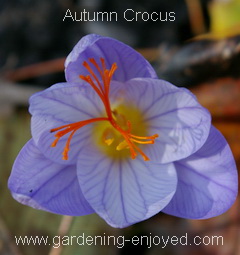
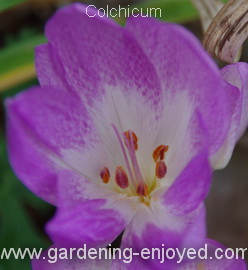
It’s autumn and that means that I get on my soap box and try to educate anyone who will listen. There are two wonderful blooms appearing in my garden as autumn progresses and they are often confused and that could have tragic consequences. The first to bloom are the Colchicums. They have large blooms on naked stalks because their foliage appears in the spring. An interesting fact about the Colchicums is the presence of their ovary underground. The pollen has to travel the length of those above ground stalks and the seeds will appear with the foliage in the spring. There are several varieties commonly available, the single pictured here, a double in the same colour and a white flowered form. There are a few other species that are not that common in trade. They have their own botanical family Colchicaceae. Now here is the problem. 2 or 3 weeks after they bloom the much smaller Autumn Crocus bloom and the
two are often confused. They shouldn’t be. The Crocus belong to the botanical family Iridaceae. One autumn species Crocus sativus produces Saffron, that expensive spice that is made from the dried stamens of that Crocus. The stamens are something that should help us to sort out the confusion. As you can see in the pictures, Colchicum have six stamens and Autumn Crocus has three. Why should we care other than for botanical correctness.
We enjoy the taste and colour of Saffron from the Crocus but all parts of the Colchicum are quite poisonous.
Most Autumn Crocus produce leaves in the spring as the Colchicum do but the Saffron producing Crocus sativus has its leaves with the flowers in the fall. Both are wonderful additions to the garden providing a few weeks of fresh flowers when everything else is fading but let’s all become experts and learn to distinguish between them.
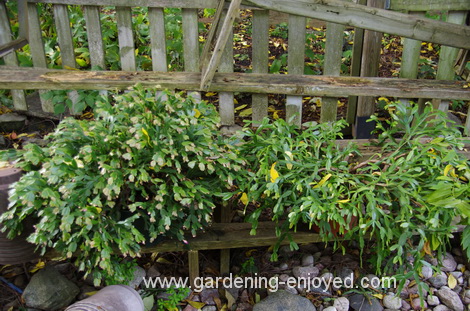 Now here’s a chore that I must get around to very soon. We have had no sign of frost in my little corner of the world so far but it is past time for that to happen. These two Cactus are part of my part time houseplant collection. They summer outside and move inside to bloom during the winter. If I don’t get them in before that first frost they will make an nice addition to the compost heap. They are both hybrids of Schlumbergera sp, one is a Thanksgiving Cactus that blooms reliably around American Thanksgiving and the other is the Christmas Cactus that is always in full bloom for that holiday. They bloom at those times because they are both short day plants, that is, they require days that are shorter then their nights to initiate their bloom cycle. They bloom at different times because they require a different number of short days to create their blooms. Keeping them outside in the
fall is an easy way to get those short days started. Once they are inside they must be kept in a place that gets lots of sunlight but no artificial light at night. Even a hundred watt bulb in the room with them will mess up their blooming. They both go into my solarium which easily provides the required conditions. Why are they still outside? Partly to get them easily started on their short days and partly because their winter homes are on high shelves in the solarium and my right shoulder, although much improved, is not excited about lifting them up that high. Later today Yes!
Now here’s a chore that I must get around to very soon. We have had no sign of frost in my little corner of the world so far but it is past time for that to happen. These two Cactus are part of my part time houseplant collection. They summer outside and move inside to bloom during the winter. If I don’t get them in before that first frost they will make an nice addition to the compost heap. They are both hybrids of Schlumbergera sp, one is a Thanksgiving Cactus that blooms reliably around American Thanksgiving and the other is the Christmas Cactus that is always in full bloom for that holiday. They bloom at those times because they are both short day plants, that is, they require days that are shorter then their nights to initiate their bloom cycle. They bloom at different times because they require a different number of short days to create their blooms. Keeping them outside in the
fall is an easy way to get those short days started. Once they are inside they must be kept in a place that gets lots of sunlight but no artificial light at night. Even a hundred watt bulb in the room with them will mess up their blooming. They both go into my solarium which easily provides the required conditions. Why are they still outside? Partly to get them easily started on their short days and partly because their winter homes are on high shelves in the solarium and my right shoulder, although much improved, is not excited about lifting them up that high. Later today Yes!
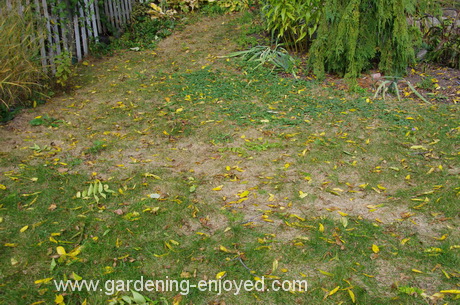
This a strange picture. There is a large section of very dead, hopefully dormant, grass in the middle of the picture. It started to go in that direction in mid August when we had little or no rain for an extended period. Why in that particular area, I asked myself, until I looked up. It very closely matches the drip line of the large Black Walnut tree. The grass normally grows quite happily there but it would be my educated guess that the Walnut was a better competitor for the limited supply of water forcing the grass to go dormant, or dead? In the middle of that dead patch there is now a small and growing patch of bright green Glechoma hederace which we know as Ground Ivy or Creeping Charlie and apparently it does not require the same moisture as the grass. It spread rapidly over the dormant grass as soon as some autumn rains arrived. It is easy to find pages of information on dealing with this weed or other pages extolling its virtues as a wild edible that
contributes flavour and nutrition to various recipes. I continue to see it as an invasive weed but must look at those other references and see if I can change my mind, by adding it to my kitchen repertoire.
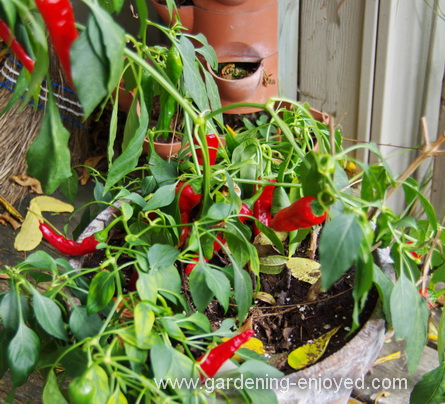
Want a little heat in your life then try growing these Super Cayenne peppers. They love to grow in containers that keep their soil warm through the season. It’s something else that I must get out and harvest before a frost tells me that I was too late. I have two methods for storing that heat for the winter. Hanging the fruit to dry and then grinding it into powder is one. My favoured technique is to make hot oil. The cleaned Peppers are boiled in some good vegetable oil such as sunflower to extract the heat and then that oil is kept in a labeled bottle beside the stove so that I can splash it into a pan for stir fries or any other recipe that requires a little kick. It will keep quite happily for a year until next year’s batch is ready. Just putting pretty red peppers into a bottle of oil will not transfer any noticeable heat to that oil.
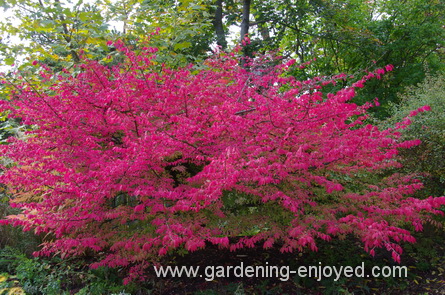
For a blast of fall colour in the yard nothing quite competes with this Burning Bush. Euonymus alatus is a hardy woody shrub who’s common name comes from the brilliant red fall colour. There is the regular form of it, pictured here, that will grow to 2 m tall and at least that wide. Its wide horizontal branching is it’s most significant feature during the growing season. There is also a dwarf form for smaller gardens that want to have that autumn colour but can’t devote as much space to a single shrub. It has interesting winged branches and often a good crop of colourful berries. It has always been one of my favourites despite its lack of colourful flowers. I just like its form and am always out in the yard admiring the colour at this time of year.
Now it’s time to answer a few of my reader’s questions. To ask a question just “reply” to this ezine. Don’t forget to check the front page of the Website for frequent short ideas for current gardening activities.
Ann Asks? You mentioned those dreaded Japanese beetles. Mine were later showing up this summer but then took over my back yard, on the roses, grape vines, climbing hydrangea, raspberry canes, and veggie beds, so much that I don't know what to do for next year. I have too many plants to cover with a bucket of soapy water to knock them into; I would be at it all day.
Would it be smart to spray some nematodes this week? We did in early summer, but I'm not sure they were meant for this type of pest. I've heard mixed reviews on the pheromone traps
Ken Answers! Japanese beetle larva live in your lawn and nematodes are one of the best ways to control them. They are usually applied in Sept but the weather has been warm enough that it may not be to late. Contact Natural Insect Control in Niagara and see if they are still shipping. That advise was
two weeks ago when I first answered it. Pheromone traps do work but they attract both your's and your neighbours beetles. It's often said that you should buy one and give it to your neighbour as gift and let him attract your beetles.
Valerie Asks?
Everything is beautiful. My potatoes were eaten by a visitor, so next year I will plant them in a container.
I was raking the leaves on my lawn and a person passing by said not to rake the leaves as they are very good for the grass. Please let me know if this is correct. Should I leave the leaves and mow the grass with them.
Ken Answers! The leaves can be beneficial to the grass but they are better raked into your garden beds. If you leave them on the grass make sure to mulch them with the mower so that they are small pieces rather then whole leaves.



 Now here’s a chore that I must get around to very soon. We have had no sign of frost in my little corner of the world so far but it is past time for that to happen. These two Cactus are part of my
Now here’s a chore that I must get around to very soon. We have had no sign of frost in my little corner of the world so far but it is past time for that to happen. These two Cactus are part of my 

